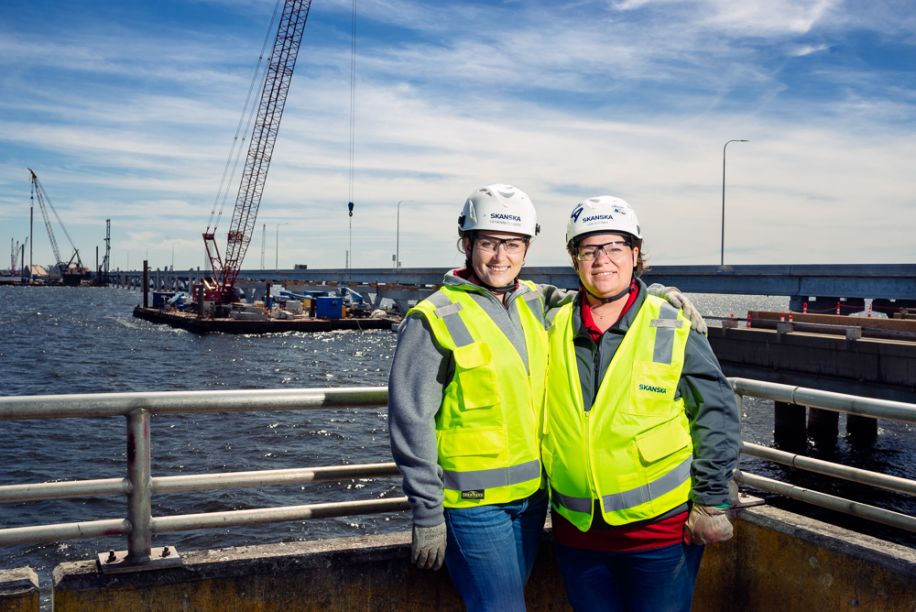By Gina Castro | Photo by Guy Stevens
When one imagines what a day in the construction industry is like, scenes of sledge hammers slamming into concrete and workers lifting heavy steel are the first to come to mind. The physical labor aspect of construction is perhaps the leading factor that caused construction to become a male dominated industry. Women make up only 9.1 percent of the construction industry. Despite the fact that women make up a small percentage of the construction industry, women are leading the largest transportation initiative in Northwest Florida history: re-construction of Pensacola’s Three Mile Bridge.
On the site of this $427 million project, the engineers are split 50-50: six male engineers, six female engineers, two male project engineers and two female project engineers. This is the first project in both Catherine Burgess’ and Lisa Flittner’s careers, the site’s project managers, where the team of engineers are split equally between men and women.

Working in construction for Flittner, who has been in construction for five years, was an easy choice. She grew up seeing her father work on various construction sites, so she had every intention of going into the same field despite seeing only one or two women work alongside her father. “[My dad] never believed in gender stereotyping or that women needed to be in the kitchen,” Flittner continued. “He made me do the exact same things that my brothers did. So, I did not see that as an issue.”
While attending university, Flittner realized her passion was engineering and landed her first job with Skanska, the construction company for the Three Mile Bridge project, as a field engineer for the New Midtown Tunnel Project in Virginia. Today, she works in the Pensacola Bay Bridge project’s pre-cast yard, where she oversees the manufacturing of pieces for the bridge and ensures that the project has enough supply.
On the other hand, Burgess, who has been in construction for 10 years, didn’t consider construction as a potential career until she attended college. Burgess grew up with three brothers and was the only girl, but her parents raised her to believe her sex wasn’t a limitation. “My dad and mom pushed me. They made me feel like I could do anything that a boy could do,” Burgess said. Even with her parent’s support behind her, Burgess never heard about women in construction. “As a child, that was never presented to me,” Burgess said. “I never thought of going into the construction industry because, you know, being a girl, they usually promote nursing or other things.”
After Burgess enrolled in an engineering program at her community college, she landed an internship with the New York Department of Transportation (DOT) and began her career in construction. Now, she works closely with the DOT teams, leading and mentoring field engineers in the project and handles forecasting for the bridge’s substructure and foundation.
Aside from the occasional “darlings” and “dears” from their male coworkers, which they address immediately, neither Burgess and Flittner feel that their sex was a challenge in their day-to-day work in the industry or as leaders within the industry.
Burgess and Flittner agreed that the two leading reasons few women are in construction is misconceptions about what construction is, for both men and women, and that many women don’t believe they can have a career and a family. Both Burgess and Flittner are mothers, and Flittner is expecting. “I think it’s women realizing that we can have it all,” Burgess said. “They think because it’s construction, you have to physically swing a hammer, which is great because there are women who do that. But there is also a different side of the construction industry: engineering. You don’t have to use muscle. You can use your brain as well.”
“Everyone still sees the construction industry as getting dirty and sweaty,” Flittner said. “They forget that there is this whole other side of it as well. I think that the more we present that to the younger generation, then it will start changing. They just don’t know about it.”
Of the 9.1 percent of women in construction, 44 percent of women work in management, which is the leading position for women in construction. The next leading position is sales and office, which is 28 percent.
Although there are few women in their positions, Burgess and Flittner see this disparity as an opportunity for empowerment. “We have a lot of younger women field engineers on this job, and even though it might not be on paper, I feel like I’m their mentor,” Burgess said. “Seeing a woman as a project engineer gives them hope that they can be promoted in this company as a female.”
“I would say I’m prideful that I’m able to pave the way for others, but there is definitely pressure to be able to pave the way for us,” Flittner said. “It makes me thankful for other women who have done this in the past.”
Both women agreed that the solution to this disparity is through education and community outreach about jobs within construction. For instance, how Skanska celebrates women in construction by doing a Women in Construction Week during the month of March, which is Women’s History Month. Burgess said that Skanska has been engaging with schools and the community to help spread this information. Skanska also recently increased maternity leave to 12 weeks, which is paid. Skanska also offers 30-day paid paternity leave. As more companies make an effort to challenge gender inequality, more of these issues can be solved.